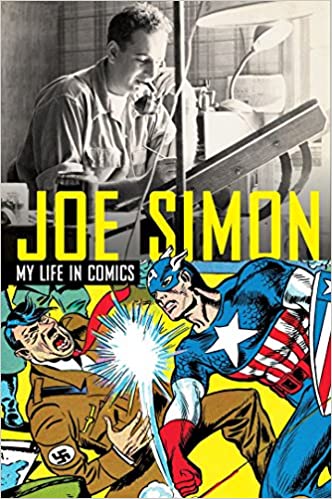
Tying in perfectly with Captain America: The First Avenger, one of the character’s co-creators, Joe Simon, has released his engaging autobiography, which offers a fascinating account of his career in the comic-book business supplemented by his personal life. His prose is very straightforward, like he’s sitting across a table from you, and the story progresses chronology for the most part. There are black and white illustrations throughout and eight glossy pages of color.
Buy Joe Simon: My Life in Comics bookSimon was raised in Rochester, NY and his artistic skills got him job at a local paper, the “Rochester Journal-American. He progressed to larger cities, eventually landing in New York City. He got jobs working for Paramount Pictures’ publicity department retouching photos and drawing illustrations or magazines. His editor for the latter, Harlan Crendall, suggested him to Lloyd Jacquet of Funnies Incorporated. Simon’s first job, he thinks, “was ‘Ranch Dude,’ a six-page western that ended up in “Amazing-Man Comics.”
Future comic book publisher Al Harvey introduced Simon to Jack Kirby, and the duo began a long partnership. They created the first issue of Captain America, which was their first submission at Martin Goodman’s Timely Comics, the precursor to Marvel Comics. Simon reveals how inspiration can come from anywhere if you are open to it as a desert led to his creation of Red Skull. After Captain America Comics #1 became Timely’s best-selling comic, Simon discovered how unfair his royalty deal was. He and Kirby joined DC Comics where they worked on Sandman and Boy Commandos, and then began to bounce around the turbulent industry over the years, even briefly starting up their own company, Mainline Publications, which was so short-lived Charlton Comics had to publish the last few issues they had begun.
Simon details the changes in the business from the first romance comic book for girls, Young Romance, which was started by he and Kirby, to the publishers’ response to the congressional hearings which in the Comics Code. Plagiarism ran rampant through the industry with DC Comics’ Superman being a frequent subject. Victor Fox had Will Eisner and Jerry Iger copy Superman to create Wonder Man and later perjure themselves during the trial. Simon was a witness when DC sued Fawcett Publications over Captain Marvel’s similarities to Superman because he worked on the former as evidenced by the court testimony included. Simon would have later legal wranglings when he attempted to regain the copyrights to his work.
Comics fans will de delighted with the varying glimpses of Jack Cole, creator of Plastic Man; artist/future DC publisher Carmine Infantino; a young Stanley Lieber, relation to Martin Goodman and future Marvel Comics creator/publisher, Superman creators Jerry Seigel and Joe Schuster; and artist Steve Ditko, who worked with Simon. There are also some precursors to Spider-Man and the Fantastic Four in characters Simon had worked on The Fly/Silver Spider and Challengers of the Unknown, respectively.
Joe Simon: My Life in Comics is a must-read for fans of comic books as it offers great insight about the history of the medium from a man who lived it.